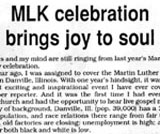‘The content of his words’

Analyzing Martin Luther King’s rhetoric; civil religion
By Bruce T. Murray
Author, Religious Liberty in America: The First Amendment in Historical and Contemporary Perspective
Martin Luther King, Jr. is remembered for his words, his deeds and his spirit. Dr. King lives on in his landmark speeches, which are embedded in the nation's consciousness. King's words are so familiar, one might overlook his particular choice of rhetoric – specifically his use of civil religion, a belief system that binds the nation’s deepest-held values with transcendent meaning.
In his call for justice, King used the language of civil religion to show how the nation had fallen short on the covenant made by America’s Founders. King fused the language of civil religion with the prophetic tradition of the African-American church. The results were unmistakable and continue to resound:
“When the architects of our republic wrote the magnificent words of the Constitution and the Declaration of Independence, they were signing a promissory note to which every American was to fall heir,” King said in his landmark “I Have a Dream” speech, Aug. 28, 1963, in Washington, D.C. “Now is the time to make justice a reality for all of God’s children.”
King lines up with Abraham Lincoln, Thomas Jefferson and John Winthrop as an exemplar in the tradition of civil religion. Barack Obama has also found his voice in civil religion, which he frequently employs in his speeches and writings:
“Imagine Lincoln’s Second Inaugural Address without reference to ‘the judgments of the Lord,’ or King’s ‘I Have a Dream’ speech without reference to ‘all of God’s children?’” Obama wrote in his book, The Audacity of Hope. (See more on Obama's use of civil religion here.)
 Religious Liberty in America: The First Amendment in Historical and Contemporary Perspective by Bruce T. Murray, analyzes King’s rhetoric in the context of civil religion. Religious Liberty in America explores the origins of civil religion and how it has been enunciated throughout American history – from colonial times up to the political career of Barack Obama. In addition to civil religion, Murray reviews the 400-year history of religious liberty in America, focusing especially on the Supreme Court, religion in public schools and faith-based initiatives. Throughout, Murray keeps a close eye on current issues, such as battles over religious symbols in the public square, the “culture wars,” and immigration.
Religious Liberty in America: The First Amendment in Historical and Contemporary Perspective by Bruce T. Murray, analyzes King’s rhetoric in the context of civil religion. Religious Liberty in America explores the origins of civil religion and how it has been enunciated throughout American history – from colonial times up to the political career of Barack Obama. In addition to civil religion, Murray reviews the 400-year history of religious liberty in America, focusing especially on the Supreme Court, religion in public schools and faith-based initiatives. Throughout, Murray keeps a close eye on current issues, such as battles over religious symbols in the public square, the “culture wars,” and immigration.
“Bruce Murray seeks to lay out historically and conceptually the issues behind the two religious liberty clauses in the First Amendment. In doing so, he introduces and traces such significant topics as the development of religious pluralism and its ironic counterpart, civil religion. Nowhere is there such a clear and concise explanation of the issues as Murray offers in this book.”
– Philip Goff, Associate Professor of Religious Studies and Director of the Center for the Study of Religion and American Culture, Indiana University-Purdue University, Indianapolis.
Religious Liberty in America is available in numerous university libraries, and it may be purchased on the University of Massachusetts Press Web site.
Find out more about the author here.
 ‘A cut above the others’
‘A cut above the others’
For a taste of what it is like to experience a worship service at an African-American church, see coverage of the Martin Luther King Day celebration at the Greater Shiloh Baptist Church in Danville, Ill.

